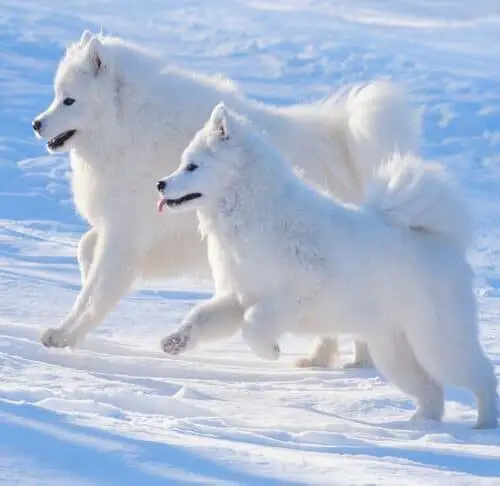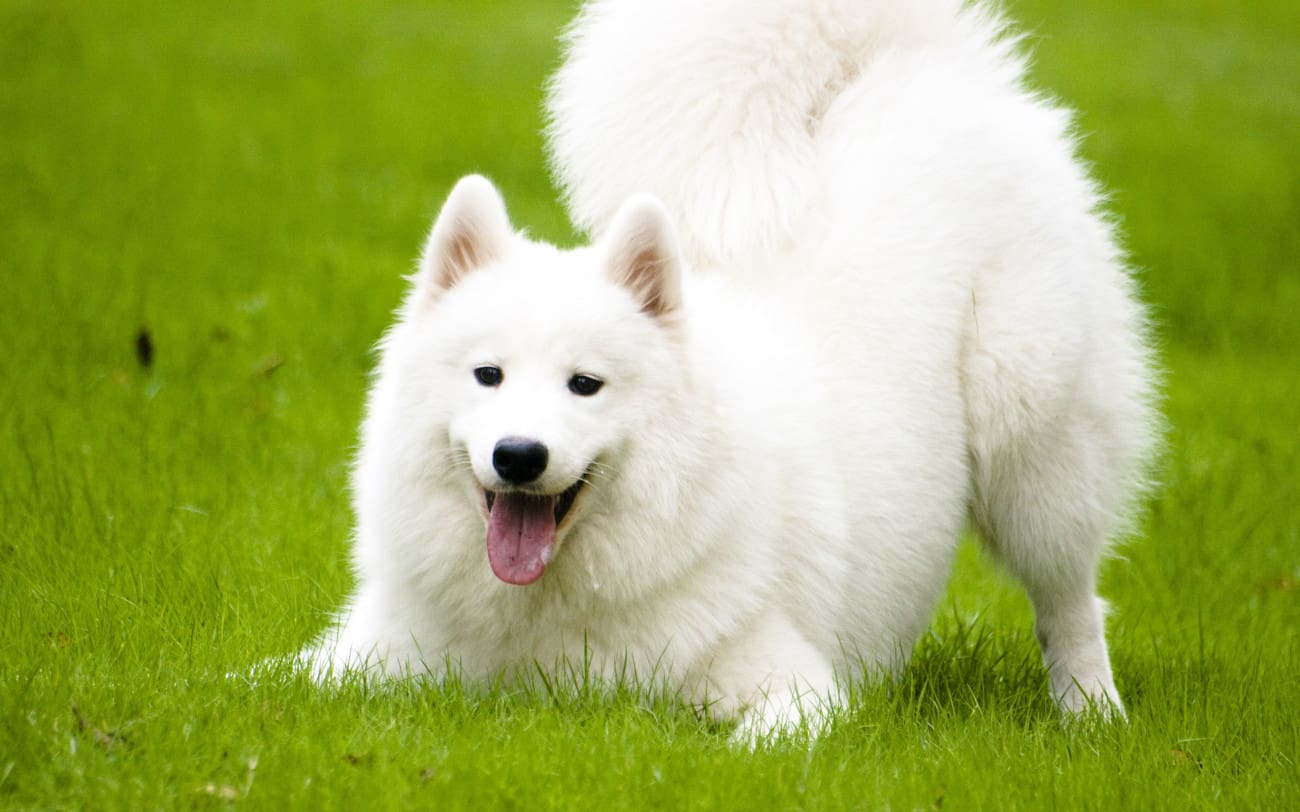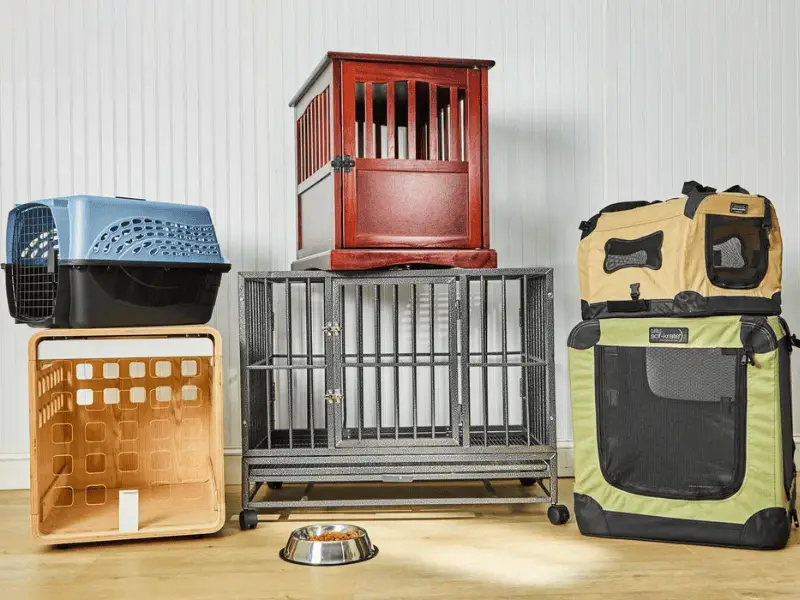You may be surprised by the Samoyed dog size! Male Samoyeds can stand up to 23.5 to 25 inches at the shoulder and weigh between 45 to 65 pounds. Females tend to be slightly smaller, standing 19 to 21 inches at the shoulder and weighing between 35 to 50 pounds.

Contrary to the deceptive fluff that might have you reaching for a lap-sized dog bed, the surprising Samoyed dog size ensures you’re going to need a lot more room — and a lot more dog food!
Despite their fluffy, cuddly appearance and friendly demeanor that might suggest they are small to medium-sized dogs, Samoyeds are actually a large breed.
The Samoyed dog breed is a fascinating and beautiful white breed. In this section, we will dive into understanding the history and origin of this breed, as well as its physical appearance and characteristics.
By exploring these sub-sections, we will gain valuable insights into the rich background and distinctive traits that make the Samoyed breed so unique.
History and Origin of the Samoyed Breed
The Samoyed breed has a deep history. It originates from the Samoyede people of Siberia. They used the dogs to herd reindeer, pull sleds, and guard camps. This breed is renowned for its intelligence, loyalty, and adaptability.
The Samoyed breed has a muscular build and elegant stature. Plus, it has a white double coat with a dense undercoat. Its eyes are almond-shaped and dark in color, giving it a friendly expression.
One unique trait of the Samoyed breed is the upturned mouth corners. This creates an adorable smile-like expression, often referred to as the “Sammie Smile”. This adds to their endearing appearance.
Samoyed Dog Size: Physical Appearance and Characteristics
Their face is endearing – friendly almond-shaped dark eyes, medium-sized erect ears, and an upturned mouth, known as the “Sammie Smile.” The coat is a double layer – a coarse outer layer and a thick undercoat for insulation in cold temperatures. It’s always white or cream-colored.
Samoyeds are friendly, gentle, and sociable. They love human interaction and form strong bonds with their owners.
They are patient and tolerant of children, even in energetic play. They are intelligent and trainable with positive reinforcement. Samoyeds need daily exercise and mental stimulation.
Samoyeds have the perfect size for cuddling – not too big to take up the whole bed.
More About the Samoyed Dog Size
Samoyed dog size plays a significant role in understanding this beloved breed. Discover Samoyeds’ average height and weight, and explore the importance of size in relation to their purpose. These factors shed light on the physical attributes that contribute to Samoyeds’s beautiful and versatile nature.
Average Height and Weight of Samoyeds
The Samoyed breed is known for its average height and weight. This contributes to its unique physical characteristics.
To illustrate the size of Samoyeds, a table can be made. It’ll have columns for categories like approximate height and weight based on gender and age.
Samoyeds also have distinctive features adding to their appeal. Such as their “Sammie Smile” – their upturned mouth corners. This charming expression reflects their friendly and sociable character, making them great family friends.
Size is key for Samoyeds – not just for cuddles but purposeful proportions!
The Importance of Size in Relation to Breed Purpose
The size of a Samoyed dog is of utmost importance. They were bred as working dogs, for herding reindeer and pulling sleds in harsh conditions. Males are slightly bigger than females, allowing them to pull heavy loads and manage snowy terrain.
Their size gives them the presence of a guardian and protector. They’re intimidating yet gentle, and their size serves as a visual deterrent while allowing them to defend their family if needed.
Their size also adds to their charm. They look majestic and stand out in any setting.
To maintain the size standards, genetics, and nutrition need to be taken into account. Balanced diets and appropriate portion sizes help them stay fit and healthy. Exercise is also important for maintaining their strength and agility.
The Samoyed’s coat and appearance add joy and warmth wherever they go!
The Samoyed’s Unique Coat and Appearance
The Samoyed breed’s distinctive white coat and upturned mouth corners captivate us with their unique appearance. Delving into the sub-sections, we will explore the characteristics of the prized Samoyed wool and the endearing “Sammie Smile.”
The Distinctive White Coat and Prized Samoyed Wool
The Samoyed breed is famous for its white coat and prized wool. This coat is dense and weather-resistant, with a soft undercoat and a longer, coarse outer coat. The white color helps to insulate and protect them from cold climates. The coat also enhances their stunning looks, making them easily recognizable.

Samoyed wool is soft and luxuriously textured, like cashmere or mohair. It can be harvested by brushing or combing their coat, as it naturally sheds throughout the year. This wool is versatile and highly sought-after.
In addition to their coat, Samoyeds have other unique features. Their “Sammie Smile” adds to their friendly appearance. Plus, they have expressive barking patterns that are part of their communication.
The white coat and prized Samoyed wool make them stand out visually. But, it also serves a practical purpose. Samoyeds captivate us with their unique attributes, whether admired for their looks or sought after for their wool. Their “Sammie Smile” proves that happiness is contagious, even in dogs!
The Samoyed’s Upturned Mouth Corners and “Sammie Smile”
The Samoyed breed is known for its distinctive feature of upturned mouth corners, commonly called the “Sammie Smile.” This gives the Samoyed an inviting and friendly appearance, boosting its popularity as a companion.
The upturned corners are the result of the facial muscles and bone structure. This creates an illusion of a smile, making them look cheerful and happy.
The Sammie Smile also communicates emotions, such as happiness, excitement, and friendliness. Owners find this endearing, and it strengthens their bond with their pets.
Though the “Sammie Smile” enhances the breed’s charm, its impact on attracting potential owners or interactions with humans has not been specified. The smile acts as an invitation for social interaction, easing any apprehension when approaching these dogs.
When considering adopting a Samoyed or interacting with one, it is important to understand the significance of the upturned mouth corners and “Sammie Smile”. This expresses their amiable temperament, making them suitable companions for individuals and families.
Samoyeds can thrive in any environment with proper care and training while spreading their contagious smiles. They are the perfect family companions, but don’t expect them to share the remote during movie night!
Samoyed Temperament and Suitability as Family Companions
Samoyed dogs have a temperament that sets them apart as ideal family companions. In this section, we will delve into their friendly and sociable nature as well as their compatibility with children and other pets.
Get ready to discover why Samoyeds are known for being loving and affectionate additions to any household.
Friendly and Sociable Nature of Samoyeds
Samoyeds, famed for their friendly natures, have a long legacy as working dogs with the Samoyede tribe. Over time, they have forged strong connections with humans. Their amiable nature makes them great family pets, as they get on well with kids and other animals.
- Samoyeds are typically friendly to strangers, making them bad guard dogs but awesome for socialization.
- They adore human companionship and can get anxious or sad if left alone for too long.
- Highly social, Samoyeds relish interactions with people of all ages, hence why they’re so popular with families.
- With their gentle and patient attitude, Samoyeds fit right in with households that have young children.
- Samoyeds are also renowned for their ability to form meaningful relationships with other animals, including cats and small critters.
Although pleasant, it’s important to remember that Samoyeds should always be supervised when around smaller creatures due to their prey drive. With proper socialization and training from an early age, you can help ensure they become well-mannered and obedient pets.
Samoyeds: the ideal playmates for kids and furry pals alike, making any home a happy and furry haven of love and laughter.
Compatibility with Children and Other Pets
Samoyeds are known for their friendly and sociable nature. They get along well with children and other pets. They are patient and gentle, making them great companions for families.
Samoyeds play and tolerate kids, so they make great playmates. Plus, they adjust easily to households with multiple animals. They also protect family members, giving kids and other pets a sense of security. Samoyeds are less likely to show aggression towards children or animals.
Prey drive is an inherent quality of Samoyeds. This doesn’t mean they will be aggressive, but it’s important to supervise them. Early socialization is key for teaching them good behavior. Introducing them to new people, animals, and environments helps them form positive associations. Obedience training also sets boundaries and encourages good behavior.
Exercise and mental stimulation keep them content and prevent behavioral issues. By giving them structure and consistency, they feel secure and happy. This helps create harmonious relationships among the kids, pets, and dog.
Samoyed Training and Exercise Needs
Samoyed training and exercise needs are crucial for successfully raising this beautiful white breed. Discover the intelligence and trainability of Samoyeds, along with their regular exercise requirements.
With their eager-to-please attitude and energetic nature, Samoyeds thrive when provided with mental stimulation and sufficient physical activity. Let’s dive into how training and exercise play a vital role in nurturing these remarkable dogs to ensure their happiness and overall well-being.
Intelligence and Trainability of Samoyeds
Samoyeds possess intelligence and trainability, making them adept at learning tasks. They have a sharp mind and hunger to make their owners proud, making training more efficient.
- Samoyeds are quick learners and are eager to explore. This makes training fun for both the dog and its master.
- They have a strong work ethic and are willing to learn in various disciplines, such as obedience, agility, and therapy.
- Moreover, Samoyeds are talented problem solvers and can adjust to different situations, making them highly versatile.
However, they have an independent streak that can complicate training. They may be stubborn or tune out with monotonous training.

To help maximize potential:
- Be the pack leader by setting rules, boundaries, and rewards. This builds trust and understanding of the trainer’s role.
- Use positive reinforcement like treats or praise to reinforce desired behaviors.
- Mix up the routine and give new challenges for mental stimulation.
Understanding Samoyeds and implementing appropriate training techniques can bring out the best of their abilities. Training not only strengthens the bond but also ensures a well-behaved pet. Exercise is essential for Samoyeds, just like bones for a dog.
Regular Exercise Requirements for Samoyeds
Samoyeds require daily exercise for their physical and mental health. Activities such as long walks, jogs, hikes, playing fetch, and swimming are great forms of exercise. It’s important to switch up activities to avoid monotony.
Additionally, Samoyeds benefit from mental stimulation with puzzles and tricks. All in all, physical and mental stimulation are necessary for a healthy and fulfilling lifestyle for Samoyeds.
Health Considerations for Samoyeds
When it comes to the health of Samoyed dogs, there are several essential considerations to keep in mind. In this section, we’ll explore common genetic conditions that the breed may be prone to and the importance of regular grooming and coat maintenance.
By understanding these factors, Samoyed owners can ensure the well-being and longevity of their beloved furry companions.
Common Genetic Conditions in the Breed
Samoyeds are renowned for their white fur and friendly temperament. But, they are predisposed to certain genetic conditions. Owners and breeders must be aware of these conditions and take the necessary precautions.
For example, Hip Dysplasia is a condition where the hip joint does not form correctly, leading to pain and mobility issues. Then there’s Progressive Retinal Atrophy (PRA), which can lead to vision loss.
Also, Samoyeds may suffer from autoimmune disorders such as hypothyroidism and autoimmune hemolytic anemia. Von Willebrand’s Disease, a blood clotting disorder, can cause excessive bleeding.
These genetic issues must be taken into account. However, not all Samoyeds will be affected. By practicing responsible breeding, including testing the parents for health clearances, the risks of these conditions can be reduced.
Pro Tip: When getting a Samoyed puppy, ensure the breeder provides health clearances and genetic tests. This will help you get a healthy pup with lower chances of any genetic conditions.
Regular Grooming and Coat Maintenance
The Samoyed’s beautiful coat needs regular grooming and care. It has a double layer of fur, an insulating undercoat, and a longer, protective fur.
Brushing to prevent tangling and matting is a must. It is also key to bathing with caution to not strip the natural oils from their skin. Slicker brushes, combs, and dematting tools are must-haves for successful grooming. Trimming the fur between the paw pads can help stop matting and give better traction.
Samoyeds tend to shed a lot during seasonal changes, so extra attention is needed. Plus, visits to a professional groomer can guarantee their coat is in top condition.
It’s also important to keep in mind that their coat provides insulation from hot and cold weather. So, monitor them when the temperature extremes to ensure they are comfortable.
By considering all this, Samoyed owners can ensure their pup looks and feels amazing! Their coat will stay fabulous for many years with regular grooming, attention to seasonal changes, and professional care.
The Samoyed’s Vocal Nature and Behavioral Traits
The Samoyed’s vocal nature and behavioral traits hold captivating insights into their communication through barking and vocalizations, as well as their prey drive and the importance of proper supervision.
Discover the unique ways in which this beautiful white breed expresses itself and how understanding their behavior can enhance your relationship with them.
Communication through Barking and Vocalizations
Communication through barking and vocalizations is a key part of the Samoyed breed’s identity. They possess a wide range of expressions, such as howling, whining, and even talking.
These vocal cues can show emotions like excitement, loneliness, or discomfort. Each Samoyed may have their own unique way of expressing themselves.

Bonding with this breed means understanding their vocal expressions. It can help create a stronger connection with your Samoyed. Fun fact: The American Kennel Club says Samoyeds often make human-like sounds, adding to their charm! Just beware of barking at squirrels!
Prey Drive and Proper Supervision
Samoyeds have a natural prey drive, so owners must provide proper supervision. This helps protect small animals and prevent hunting behavior. Owners should create a controlled environment and train their Samoyed consistently to manage their prey drive.
Additionally, Samoyeds are usually friendly with kids and other pets. However, setting boundaries and socializing them from a young age is important. This will keep the prey drive from harming smaller animals.
An owner once described her experience with her Samoyed’s prey drive while they were walking in a park. The Samoyed became fixated on a group of ducks, but she was able to redirect its attention back to her. This story illustrates the need for active supervision when managing a Samoyed’s prey drive. (Reference: 7.2 Prey Drive and Proper Supervision).
Adapting to Different Climates and Environments
Adapting to different climates and environments, discover how the Samoyed dog thrives in various living conditions with a preference for cooler temperatures.
The Samoyed’s Preference for Cooler Temperatures
Samoyeds have a strong preference for cool temperatures because they originate from Siberia. Their double-layered coat helps them to stay warm and their body temperature is regulated in cold climates.
The outer layer is water-resistant, so moisture can’t penetrate. They also have a compact build and sturdy frame so they can easily move around in snow and ice.
Plus, they are more active and energetic in colder seasons. They love outdoor activities, such as playing in the snow and pulling sleds. But in hot weather, they may seek shade or cool surfaces to lie on.
Owners must provide their Samoyed companions with appropriate living conditions that suit their preference for cooler temperatures. They need access to shade or air conditioning during hot weather. Also, they should stay warm during colder periods.
Samoyeds can survive in many environments – from snowy hills to apartments – as long as their owners can manage the shedding.
Thriving in Various Living Conditions
The Samoyed breed is one that can thrive in a range of habitats. They have a resilient nature, allowing them to adapt to cold and warm climates alike.
Historically, they were used by the Samoyedic people for herding and sledding in Arctic regions. Their thick double coat provides insulation against the cold and helps regulate body temperature.
Yet, they can also live in warmer climates but need shade and water to stay cool.
This breed is highly adaptable and sociable, which allows them to adjust to new surroundings. This makes them suitable for many living situations, such as apartments or houses with large yards.
Regular exercise is important for Samoyeds regardless of their living conditions. This can be met with daily walks, playtime, or dog sports. Exercise keeps them physically fit and provides mental stimulation.
Samoyed Ownership and Care Tips
Owning a Samoyed requires proper care and attention. In this section, we will provide valuable tips on early socialization and training for Samoyeds and highlight the importance of veterinary care and their lifespan. Stay informed to ensure a happy and healthy life for your beautiful white Samoyed.
Early Socialization and Training Recommendations
Early socialization and training are musts for Samoyeds to become great companions. Interacting with other pups, people, and different surroundings from a young age is vital so they develop confidence and flexibility. Reward-based training is very useful when teaching Samoyeds important commands and good conduct.
- Introduce Samoyed puppies to various sounds, sights, and smells so they know their environment and don’t become scared of new things.
- Introducing them to people and animals early helps build positive relationships. Especially with kids, since Samoyeds are friendly and make wonderful family pets.
- Be consistent in training Samoyeds. Set clear boundaries and rules from the start to stop bad behaviors. Positive reinforcement methods like treats or praise when they do something good.
Provide mental stimulation via interactive toys or puzzles. This prevents boredom and destructive behavior. Attend obedience classes or try activities like agility or tracking to improve training.
Early socialization also helps spot potential behavioral issues that need a professional assessment. Timely detection of problems makes sure owners can manage them correctly.
Vaccinate Samoyed puppies according to veterinary guidelines to protect against common diseases. Regular check-ups and grooming are essential for their health and coat.
By doing all this from the start, owners will have a happy and well-adjusted Samoyed companion that will bring joy for years to come. Veterinary care is important, as Samoyeds have a short lifespan, teaching us this lesson with their fluffy and fleeting existence.
Lifespan and Importance of Veterinary Care
The lifespan of a Samoyed is 12-14 yrs, but with proper vet care, they can live longer. Regular check-ups, vaccinations, and treatments are essential for their well-being. They’re prone to genetic conditions like hip dysplasia and PRA. Visits to the vet can help diagnose and manage them.
Dental care’s important as they’re susceptible to periodontal disease. Vets provide guidance on nutrition and weight management.
Owning a Samoyed requires a commitment to their long-term health. Daily grooming’s necessary for maintaining their white coat, including brushing to prevent matting and removing loose hair.
Samoyeds in Popular Culture and Recognition
Samoyeds have made a mark in popular culture and have gained recognition in various fields. This section explores the growing presence and impact of these beautiful white dogs, from their appearances in media and show dog competitions to the availability of prominent organizations and resources for Samoyed adoption.
Discover how Samoyeds have captured the hearts of people everywhere, and find out where you can get involved or learn more about this beloved breed.
Samoyeds in Media and Show Dog Competitions
Samoyeds have made a splash in media and show dog competitions thanks to their mesmerizing white coats and endearing features. They boast an upturned mouth corner which gives them a uniquely cheerful smile, adding to their captivating presence.

Their playful nature and ability to socialize make them ideal for media work, demonstrating their alluring charisma. Showcasing their characteristics in such events helps promote the breed, making it more noteworthy to the public.
Apart from being eye-catching showstoppers, Samoyeds possess additional qualities that make them excellent partners for owners. Their gentle nature and ability to adapt make them perfect for various performances and competitions.
Whether in films or the show ring, these pooches never fail to impress with their beauty, intelligence, and charm.
Plenty of organizations and resources are out there for those looking for their perfect Samoyed companion. With these in mind, finding your own fluffy friend is easier than ever!
Organizations and Resources for Samoyed Adoption
Prominent organizations and resources exist to help those looking to welcome a Samoyed into their home. These organizations provide support and guidance throughout the adoption process. Such as:
- Samoyed Rescue Alliance: They specialize in rescuing and rehoming Samoyeds. Working with dedicated volunteers, they ensure the well-being of these dogs and match them with forever homes.
- National Samoyed Rescue: This nationwide network of volunteers rescues Samoyeds from shelters, relinquishments, and strays. They provide medical care, rehabilitation, and loving homes.
- Samoyed Club of America: This reputable organization offers info on responsible breeders adhering to ethical breeding practices. Plus, they provide instructional resources for potential adopters.
For more info and assistance with Samoyed adoption, visit the orgs’ sites or contact them directly. They display a commitment to the well-being and proper placement of Samoyeds.
When considering Samoyed adoption, research and understand the specific needs of this breed. Choose an org or breeder that prioritizes health testing, socialization, and proper dog care. Doing this ensures the best possible home for the new furry companion.
Final Thoughts on Samoyed Dog Size
Samoyeds have a majestic appearance, with thick double coats and fluffy tails! When it comes to size, males are between 21-23.5 inches tall and weigh 50-60 pounds. Females are usually 19-21 inches tall and weigh 35-50 pounds.
Besides size, Samoyeds can be prone to certain genetic diseases such as progressive retinal atrophy and hip dysplasia.
To ensure their well-being, they require regular physical and mental stimulation. Walking, jogging, and playing fetch are great for them. Ample space to roam and explore is also beneficial.
Grooming your Samoyed regularly also helps keep their beautiful coat healthy.
Key Facts About Samoyed Dog Size:
- Samoyeds are medium-to-large-sized dogs, with males being slightly taller than females.
- The average height of a male Samoyed is between 21 to 23.5 inches, while females stand between 19 to 21 inches tall.
- Male Samoyeds typically weigh between 50 to 65 pounds, and females weigh between 35 to 50 pounds.
- Samoyeds have a compact and sturdy build, with a broad chest and a moderately retracted belly.
- The Samoyed breed is known for its elegant and lively appearance, including a wedge-shaped head, almond-shaped dark brown eyes, and erect, triangular ears.


